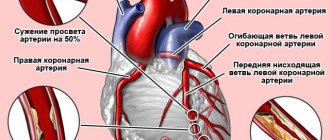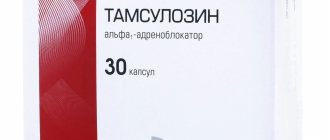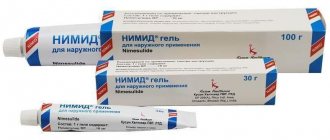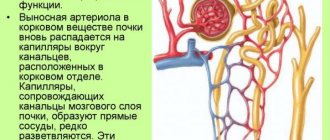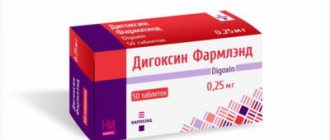pharmachologic effect
Ethambutol is a synthetic derivative of ethylenediamine. The drug has a specific antibacterial effect against Mycobacterium bovis and tuberculosis, certain atypical (non-tuberculous, opportunistic) types of mycobacteria. Does not show activity against other bacteria, viruses, fungi. Has a bacteriostatic effect. It is active against mycobacteria resistant to other anti-tuberculosis drugs, and therefore is a second-line anti-tuberculosis drug.
Primary resistance of M. tuberculosis and bovis to Ethambutol is observed quite rarely; secondary resistance develops slowly.
Ethambutol can be used in conjunction with other anti-tuberculosis drugs.
Method of administration and dosage of Ethambutol
The drug is intended for oral administration.
Ethambutol is prescribed for use as part of complex therapy once a day at 15-25 mg per kg of weight or 2 times a week at 50 mg per kg of weight or 3 times a week at 25-30 mg per kg of weight.
When the patient's condition is stabilized, Ethambutol is taken at a dose of 15 mg per kg of body weight per day.
As an alternative method, the drug is prescribed throughout the entire treatment period at 15 mg per kg of body weight per day.
Ethambutol's tolerance increases if it is taken after meals.
The duration of drug therapy is determined by the form of the disease and the treatment regimen used. On average - 6-12 months.
Similar drugs:
- Nevigramon Capsule
- Pyrithion zinc Substance-powder
- Cinocap Cream for external use
- Klacid Oral tablets
- Faringosept Lozenges
- Doxycycline Lyophilisate for solution for injection
- Riodoxol ointment Ointment for external use
- Benzamycin Gel for external use
- Alpisarin ointment Ointment for external use
- Synthomycin Liniment
** The Drug Directory is intended for informational purposes only. For more complete information, please refer to the manufacturer's instructions. Do not self-medicate; Before starting to use the drug Ethambutol, you should consult a doctor. EUROLAB is not responsible for the consequences caused by the use of information posted on the portal. Any information on the site does not replace medical advice and cannot serve as a guarantee of the positive effect of the drug.
Are you interested in the drug Ethambutol? Do you want to know more detailed information or do you need a doctor's examination? Or do you need an inspection? You can make an appointment with a doctor - the Euro lab is always at your service! The best doctors will examine you, advise you, provide the necessary assistance and make a diagnosis. You can also call a doctor at home . Euro lab clinic is open for you around the clock.
** Attention! The information presented in this medication guide is intended for medical professionals and should not be used as a basis for self-medication. The description of the drug Ethambutol is provided for informational purposes and is not intended for prescribing treatment without the participation of a doctor. Patients need to consult a specialist!
If you are interested in any other drugs and medications, their descriptions and instructions for use, information about the composition and form of release, indications for use and side effects, methods of use, prices and reviews of drugs, or you have any other questions and suggestions - write to us, we will definitely try to help you.
Side effects
The drug may cause the following side effects:
- retinal hemorrhage, optic neuritis;
- headache, dizziness;
- disorientation;
- malaise;
- hallucinations;
- peripheral polyneuritis;
- confusion;
- paresthesia;
- hypersensitivity reactions in the form of rash, itching, fever, leukopenia, tachycardia, vasculitis, arthralgia, Lyell and Stevens-Johnson syndromes, anaphylactic shock;
- heartburn;
- anorexia;
- diarrhea;
- vomiting;
- stomach ache;
- jaundice;
- metallic taste in the mouth;
- disturbances in liver function;
- interstitial nephritis;
- thrombocytopenia;
- leukopenia;
- acute attack of gout;
- decreased clearance of uric acid.
Side effects of Ethambutol most often occur in patients with diabetes mellitus, renal failure, chronic alcoholism, and elderly patients.
Contraindications
Contraindications to the use of Ethambutol are hypersensitivity and intolerance to the components of the drug, visual impairment and cataracts, inflammatory eye diseases, diabetes mellitus, renal and liver failure, pregnancy and breastfeeding, children under 13 years of age.
The drug should be taken with caution to patients driving vehicles and working at hazardous facilities. Ethambutol may reduce concentration and cause lethargy.
Overdose
Symptoms of an overdose of Ethambutol manifest themselves in the form of neurological disorders (damage to the optic nerve), lack of appetite, diarrhea, vomiting, fever, dizziness, headache, hallucinations, confusion, depressed breathing, asystole.
Treatment of overdose is symptomatic. Gastric lavage, inducing vomiting, and taking activated charcoal are advisable only immediately after taking the drug.
Forced diuresis, peritoneal dialysis or hemodialysis are also indicated. In case of threatening conditions, an exchange blood transfusion is performed.
Pharmacological properties of Ethambutol
Ethambutol actively penetrates mycobacterial cells, prevents their reproduction and development, and also disrupts cellular metabolism and destroys infections in the respiratory tract. The drug is effective in eliminating streptococcus, staphylococcus and Mycobacterium tuberculosis. Ethambutol even destroys bacteria that are resistant to other anti-TB drugs.
After taking the drug, the therapeutic effect is achieved within 24 hours. Ethambutol is absorbed by 80% and reaches maximum plasma concentration within 24 hours. The concentration in the lungs is 6-8 times greater than the concentration in the blood. The drug creates several inactive metabolites, which are excreted from the body by the kidneys in urine and feces.
Interaction with other drugs
When taking Ethambutol simultaneously with aluminum hydroxide, the absorption of Ethambutol from the digestive tract decreases.
Ethambutol may reduce the effectiveness of digitoxin.
When used simultaneously with isoniazid, optic neuropathy may increase,
Ethambutol may alter zinc metabolism.
Pyrazinamide and Ethambutol act synergistically to remove uric acid from the body.
When used simultaneously with disulfiram, the serum concentration of Ethambutol may increase and its toxicity may increase.
The toxic effect of Ethambutol on vision is enhanced by ethyl alcohol, so during therapy with the drug it is necessary to avoid alcohol.
Pharmacotherapeutic group.
Antimicrobial agents for systemic use.
Agents that act on mycobacteria. Antituberculosis drugs. Ethambutol. AT code X
J04A K02.
Pharmacological properties.
Pharmacodynamics.
Ethambutol has a pronounced bacteriostatic effect against Mycobacterium tuberculosis
, as well as some atypical mycobacteria (
M.avium , M.kansasii , M.xenopi )
. The drug inhibits the proliferation of mycobacteria resistant to streptomycin, isoniazid, para-aminosalicylic acid (PAS), ethionamide, kanamycin and other anti-tuberculosis drugs. The mechanism of action of ethambutol after its penetration into the mycobacterium is associated with inhibition of RNA and protein synthesis, the ability to interact with ions of divalent biometals (copper, magnesium), disruption of the structure of ribosomes and inhibition of the intensity of lipid metabolism. About 1% of patients have primary resistance to the drug. With monotherapy for tuberculosis, tolerance develops quickly.
Pharmacokinetics.
When administered orally, 75-80% of the drug is absorbed from the digestive tract. Simultaneous food intake enhances and accelerates the absorption process. The maximum concentration of ethambutol in the blood is reached after approximately 2 hours and is 4-5 mcg/ml when the drug is administered at a dose of 25 mg/kg and 8-9 mcg/ml when the drug is administered at a dose of 50 mg/kg. Binding to blood plasma proteins depends on the dose taken and is 10-40%. The half-life (T½) is 3.3-3.5 hours. A feature of the pharmacokinetics of ethambutol is that it selectively accumulates in erythrocytes (the concentration is 2 times higher than in blood plasma). Ethambutol penetrates into the cerebrospinal fluid, through the placenta and into breast milk. The drug is excreted primarily unchanged in the urine. Approximately 10-20% of ethambutol is excreted in feces in the form of inactive metabolites (aldehydes, dicarboxylic acids). Prescribing ethambutol for impaired renal function can lead to its accumulation in the body.
special instructions
Before starting Ethambutol therapy, an ophthalmological examination of the patient should be performed to determine the ability to distinguish colors, visual acuity, visual fields, examine the fundus, and measure intraocular pressure.
During treatment with the drug, you must be examined by an ophthalmologist every 2–4 weeks.
In persons with kidney problems, an ophthalmological examination should be performed every week.
Before starting therapy, the patient should be warned about possible visual impairment and side effects, in the event of which he should consult a doctor.
If visual impairment occurs, Ethambutol therapy is discontinued in order to prevent optic nerve atrophy.
Most often, visual impairments are reversible, especially if they are detected in the early stages of treatment.
For visual impairment caused by taking Ethambutol, cyanocobalamin or hydroxycobalamin is prescribed. Vision is restored within several weeks (months). Sometimes vision changes are irreversible. The level of decrease in visual acuity and optic neuritis depend on the duration of treatment with the drug and its dosage.
Ethambutol should be prescribed very carefully to patients with hyperuricemia or gout.
Before starting therapy and during it, it is necessary to constantly monitor the functioning of the liver and kidneys.
Ethambutol capsule
Instructions for medical use of the drug
Description of pharmacological action
A chemotherapy agent that has a bacteriostatic effect on typical and atypical mycobacterium tuberculosis. The mechanism of action of the drug is associated with rapid penetration into the cell, where lipid metabolism and RNA synthesis are disrupted, magnesium and copper ions bind, the structure of ribosomes and protein synthesis in bacterial cells are disrupted. Affects intracellular and extracellular species of bacteria. About 1% of patients have primary drug resistance. Ethambutol is well absorbed in lung tissue and can reach concentrations 5-9 times higher than in blood serum, and penetrates well into many tissues and organs. The intracellular concentration in erythrocytes is two times higher than in blood serum.
Indications for use
- pulmonary tuberculosis; - extrapulmonary tuberculosis.
Release form
capsules 250 mg; jar (jar) 250; Composition: 1 capsule contains ethambutol 250 mg; in jars of 250 pcs.
Pharmacodynamics
A chemotherapy agent that has a bacteriostatic effect on typical and atypical mycobacterium tuberculosis. The mechanism of action of the drug is associated with rapid penetration into the cell, where lipid metabolism and RNA synthesis are disrupted, magnesium and copper ions bind, the structure of ribosomes and protein synthesis in bacterial cells are disrupted. Affects intracellular and extracellular species of bacteria. About 1% of patients have primary drug resistance. Ethambutol is well absorbed in lung tissue and can reach concentrations 5-9 times higher than in blood serum, and penetrates well into many tissues and organs. The intracellular concentration in erythrocytes is two times higher than in blood serum.
Pharmacokinetics
Ethambutol is quickly and 80% absorbed from the digestive tract. The minimum inhibitory concentration is 1 mg/ml. After oral administration of a single dose of 25 mg/kg body weight, a Cmax in serum of 2-5 μg/ml is achieved after 2-4 hours; after 24 hours, the concentration is less than 1 μg/ml. 20-30% bound to plasma proteins. Ethambutol is metabolized in the liver into dicarboxylic acid derivatives. T1/2 is 3-4 hours, and in case of renal failure it is extended to 8 hours. Within 24 hours, more than 50% of the drug dose is excreted in the urine unchanged, and 8-15% in the form of inactive metabolites. About 20-22% of the initial dose of the drug is excreted unchanged in the feces. Ethambutol crosses the placenta. In the blood of the fetus, the concentration of ethambutol is approximately 30% of the concentration of the drug in the blood of the mother.
Use for renal impairment
Contraindication: severe renal failure. For kidney diseases, the dose of the drug depends on the degree of renal failure, an indicator of which is CC.
Contraindications for use
- inflammation of the optic nerve; - cataract; - diabetic retinopathy; - inflammatory eye diseases; - severe renal failure; - gout: - pregnancy; - lactation, - children under 13 years of age; - hypersensitivity to the drug.
Side effects
Retrobulbar inflammation of the optic nerve, unilateral or bilateral (weakened visual acuity, impaired color perception, the presence of central or peripheral scotoma, limited visual field). The occurrence of visual impairment depends on the duration of treatment and existing diseases of the eyeball. If they occur, treatment with ethambutol should be discontinued. Vision changes are usually reversible, disappearing after stopping treatment within a few weeks, or in some cases within a few months. In exceptional cases, changes in the eyeball are irreversible due to optic nerve atrophy. Allergic reactions: skin rash, itching, joint pain, fever, leukopenia. Gastrointestinal disorders: metallic taste in the mouth, nausea and vomiting, abdominal pain, lack of appetite. From the central nervous system: headaches and dizziness, confusion, disorientation, hallucinations, convulsions. From the urinary system: increased levels of uric acid in the blood serum, the phenomenon of uric acid diathesis.
Directions for use and doses
Orally, once, 20-25 mg/kg/day or (adults only) - 50 mg/kg 1-2 times a week. For children - the highest single dose is 25 mg/kg/day.
Overdose
Cases of overdose with ethambutol have not been described. Measures in case of possible overdose: induce vomiting, perform gastric lavage.
Interactions with other drugs
Aluminum hydroxide reduces the absorption of ethambutol from the digestive tract. Ethambutol alters the metabolism of some trace elements, mainly zinc.
Special instructions for use
In patients with renal failure, the dose of ethambutol should be reduced due to the accumulation of the drug in the body. Before starting treatment with ethambutol, ophthalmological monitoring should be carried out periodically: examination of the fundus, visual fields, visual acuity and color perception. It is recommended to periodically monitor the functions of the liver, kidneys and general blood tests. Effect on the ability to drive vehicles and operate machinery Due to the possibility of visual impairment (reduced visual acuity, limited field of view, color vision disturbance in relation to green and red), during treatment with ethambutol, you should not drive cars or operate moving mechanical equipment.
Storage conditions
List B.: In a dry place, at a temperature of 15–25 °C.
Best before date
36 months
ATX classification:
J Antimicrobials for systemic use
J04 Drugs active against mycobacteria
J04A Anti-tuberculosis drugs
J04AK Other anti-tuberculosis drugs
J04AK02 Ethambutol

